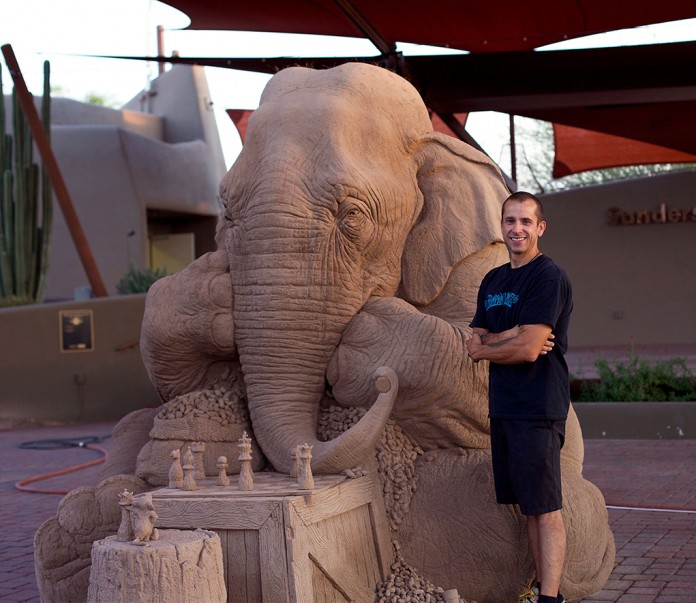Thousands of fans and visitors have poured over social media and visited the Town of Carefree to see the life-size sand sculptor of an elephant playing chess with a mouse. While carving this masterpiece within the Carefree Desert Gardens, many residents and visitors inquired as to why Ray chose an elephant and how he came up with the idea. Most of the “why an elephant” comments were from people checking to see if there was some political importance to the representation. Definitely no political agendas here! Ray originally thought of sculpting a Ganesha elephant balancing stones on his feet, trunk and tail and eventually passed on that idea as it seemed a bit too intricate.
In an attempt to design an easy sand sculpture given the size of the sand pound up, he chose to stick with an elephant. It fills the necessary space and allows for playful textures and folds. The color of the sand coupled with its scale really became inviting elements to explore. He then imagined that at a quick glance it could easily read like a real elephant. Imagining a realistic interpretation void of any Hindu influence. Just a peaceful looking elephant sitting and meditating. Soon he began to think that the sculpture would then lack dimension. It would not engage the viewer enough to realize there is more to interpret.
In most of Ray’s exhibitions he thinks to allow the onlooker to actually immerse themselves literally into the scene. So originally he was going to have an orangutan siting at a chess board allowing the opponent to be the viewer who could then step into the scene for a photoshoot. He quickly scratched that idea and switched out the orangutan for an elephant. A bit concerned that the piece would become damaged over time if he had viewers stepping into the scene. A mouse seemed like an obvious choice for an opponent. The simplicity of it excited Ray and he quickly roughed out a scaled model that represented one foot of sand for every inch of the working model. This made blocking in the actual sand piece very helpful.
The type of sand he uses varies with each location. The sand delivered to the Town of Carefree was sourced from A & A materials in Phoenix. It was collected from the Salt River in Arizona and could more accurately be described as river silt. Finer than your average beach sand. The magic of the undercuts does not come from additives or glues. Tremendous effort was made to compact 25 tons of sand into wooden boxes stacked vertical like a pyramid. Wet down with water then thoroughly compacted using gas powered construction tampers. They continued this process every 8 inches until they reached a desired height of 7.5 ft. This took several days to prepare and settle. Ray and his team then peeled off the top box and began to carve into the very dense material. Compaction is key. No need for glue or binders, just sand and water. It is desirable to keep the surface moist while carving but once an area is complete it is okay to allow it to dry. If too much material is shoveled away you can then mix up wet sand and smear it onto the existing sculpture in layers. This additive ability can make sand sculpting much more forgiving than most other subtractive materials. Areas that are built up like this are much weaker than the original pound up and should not be undercut as much. Severe undercuts can collapse even the best pound ups.
Ray’s partner on this project was Sue Beatrice, a professional artist from Long Island, New York. They have worked together on numerous pieces, most recently on one of Ray’s most comprehensive fall exhibits located in Carefree, Arizona called “the Enchanted Pumpkin Garden” carving exquisite pumpkins. Ray calls upon Sue because she is a talented sculptor but also a creative and resourceful thinker. Their minds play well together. She was integral in focusing on the elephants ears, hair (palm fibers), chess board, box and mouse among other areas.
For years I have wanted to sculpt sand without a deadline. It always felt rushed as inevitably Ray had to catch a plane ride home or a strict contest deadline to meet. The Town of Carefree this past year contracted me to work in their public year round in their Desert Garden as though it was my own little playground. The Director of Marketing, Gina Kaegi, has supported Ray’s creative process knowing that he never compromises on the end result which is a finished product of art like “no other”. Visitors have gathered from all over the country for Rays’ fall Enchanted Pumpkin Garden to this recent sand sculpture exhibit. Ray has shared his excitement to approaching sand sculpting this way from here on out and is eager to create another exhibit in the future. He wants to grant himself and any contributing artists an opportunity to push the limits with this beautiful material in a relaxed carefree way.
More information on Ray’s work can be accessed at Villafane Studios and VisitCarefree.com





